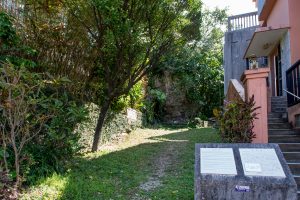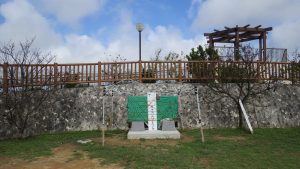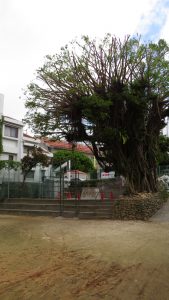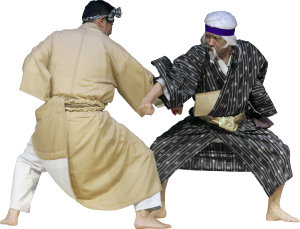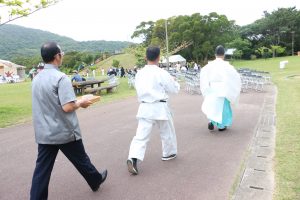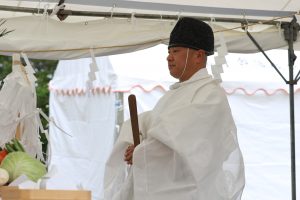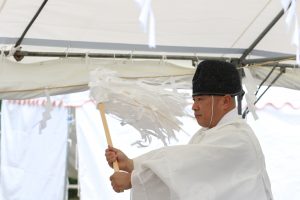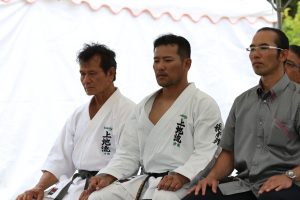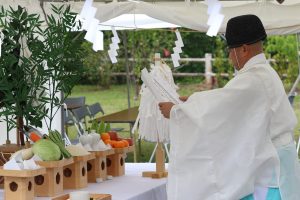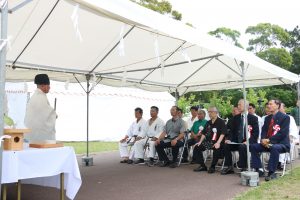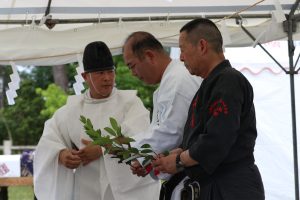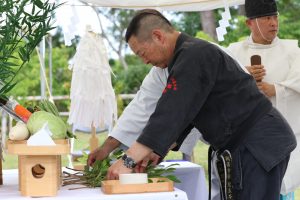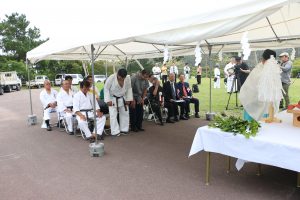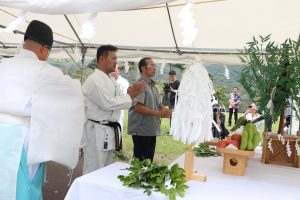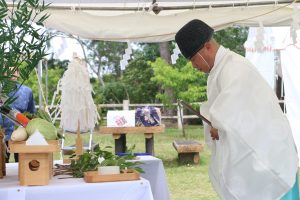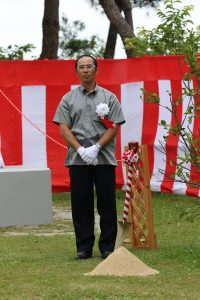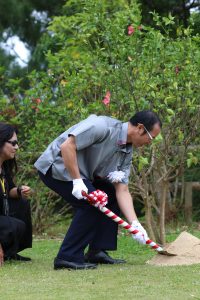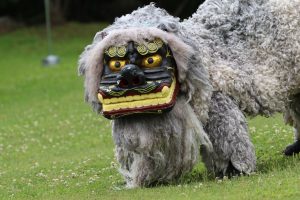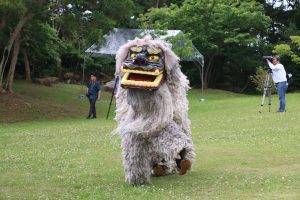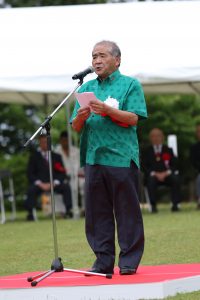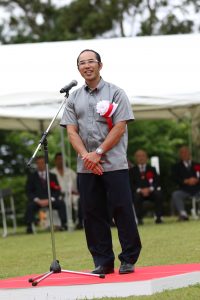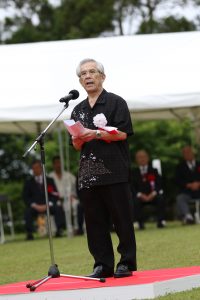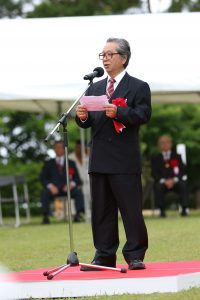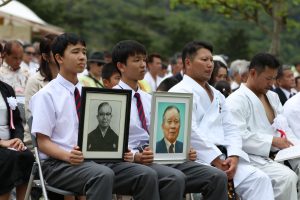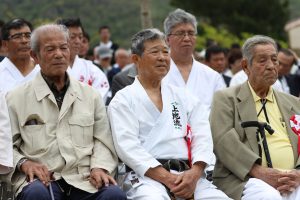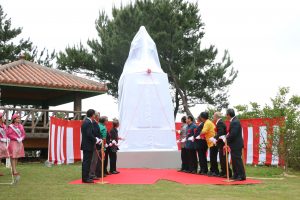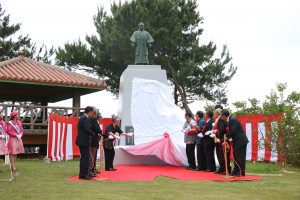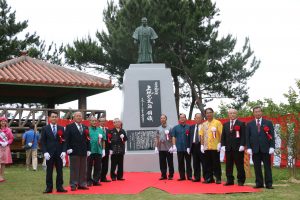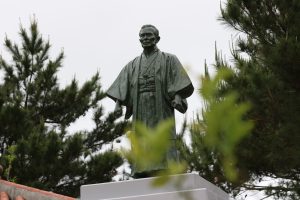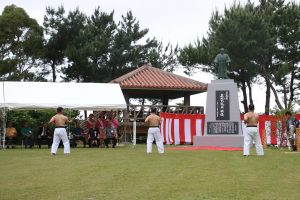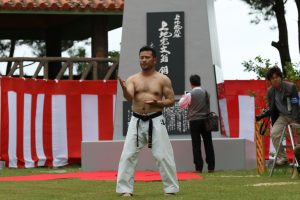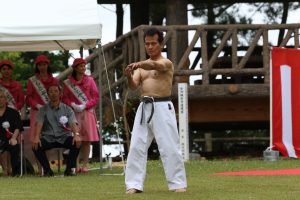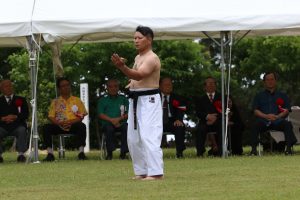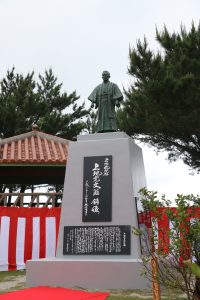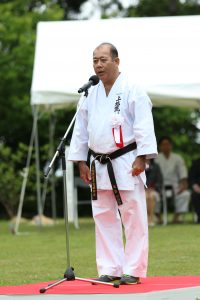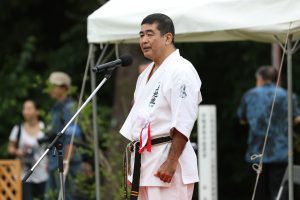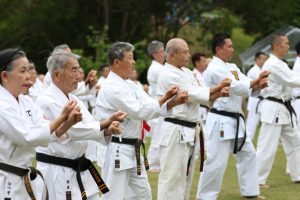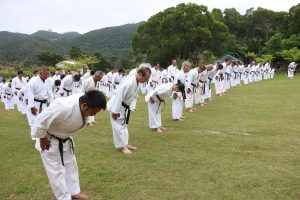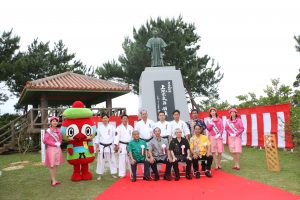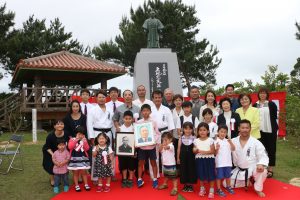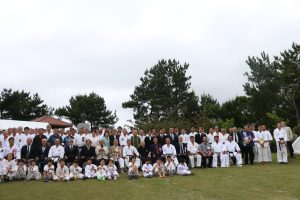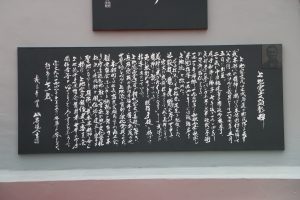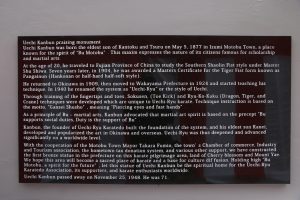In 1522, Nakasone Toyomiya Genga of Miyako donated a treasured sword to the king (1). As the king's guardian sword, it was named Jiganemaru (2).
Kyō Ahagon Jikki, (birth and death dates unknown) was entrusted with King Shō Shin’s precious sword and travelled to Kyōto to have it examined. In Kyōto, he contracted a sword sharpener and after the task was completed, he successfully brought the treasured sword back to the king.
However, it turned out that the sword that he brought back was replaced for another one by the sword sharpener. So fine was the Jiganemaru that it raised the desire of the sharpener. Realizing that the sword he brought back to Ryūkyū wasn’t the original one, Kyō Ahagon returned to Kyōto. After three years of search for the sword, he finally found it and succeeded in bringing it home safely.
The king was delighted and gave Kyō Ahagon many rewards. The fame of Kyō Ahagon’s bravery increased more and more. The more the fame rises, the more people would envy him until they were finally able to attract the attention of the king. As he could not punish Kyō Ahagon on false charge, the king invited him to the court room for a chat, offering him some tea. After a while, a young man looking for an opportunity moved forward and stabbed Kyō Ahagon with a dagger.
This story is written in the book “Kyūyō”, retracing the history of the Ryūkyū. In the part depicting the episode, it is written as follow. “He broke the youth's femora (3) using karate (4)”. While it is unclear if karate was studied as a martial art, at that time, Chinese were already established in the Ryūkyū. Furthermore, since 1372, tribute trade was actively being held, it can be imagined that Chinese martial arts influences on the local art of Tī were happening. All this make this record quite interesting.
Episodes about Kyō Ahagon can also be found in the books “Ryūkyū Yūraiki” (1713) and “Ryūkyū koku Kūki” (1731).
It is unknown if the historical figure Kyō Ahagon Jikki was a disciple of karate. Yet, his grave is still preserved in Shuri. It is located in Shuri Samukawa, behind the Mezura Dake - peak.
Source: Okinawa Karate no Teihon (Unpublished resource compiled by Tsuha Kiyoshi as ordered by the now terminated Okinawa Karatedō kobudō Support Center)
(1) Most likely it is King Shō Shin who was on the throne between 1477 till 1526.
(2) The Jiganemaru is preserved at the Naha City Historical Museum. A photo is available at this link.
http://www.rekishi-archive.city.naha.okinawa.jp/archives/item1/2059
(3) In the Japanese text, “Mata” could also be translated in “the crotch, the thigh, the groin”.
(4) In the Japanese text, karate is written “open hand".
On the eve of the First Okinawa karate international tournament, Shurite & Shōrin-ryū will be honored on July 28th and 29th.
This year marks the 232nd anniversary of Sakugawa Kanga, a master known as Tōdē Sakugawa. Born in Shuri, he is remembered for creating the bō - staff kata Sakugawa no kun.
On Saturday July 28th, led by Nakamoto Masahiro sensei, holder of the Okinawa prefecture-designated intangible cultural asset “karate & kobudō”, the monument honoring the land where originated Shurite karate and kobudō will be unveiled. The venue is Sakiyama Park in Shuri, Naha City. The unveiling ceremony will be held at 11 am. After the unveiling ceremony, a celebration, karate demonstrations and hatagashira - flag poles performances are scheduled.
On Sunday July 29th, led by the chairman of the Okinawa Shōrin-ryū (Kobayashi-ryū) Karatedō Association Miyagi Takeshi sensei, a monument praising the founder of the style Shōrin-ryū Chibana Chōshin sensei will be unveiled. The venue of the ceremony is the community hall square of Shuri Yamakawa in Naha city. The ceremony is scheduled for 10:00 to 12:00.
(Left, the monument in Sakiyama Park. Right, the square of the Yamakawa community hall)
On May 24th, the Ryūkyū Shinpō Newspaper published a cultural column titled “Easy to understand Okinawan history ~ Interpreting social changes.” The author is Mr. Kurima Yasuo. Born in 1941 in Naha City, he is an Okinawa historian, agricultural scientist and emeritus professor at Okinawa International University.
In his article, the words “Bushi · Samurē · Shizoku” which are often used in the world of Okinawa karate are explained in an easy-to-understand manner. Therefore we take the liberty to reproduce a part of the article in Japanese and present a translation below.
According to Mr. Kurima, there is very little war in Okinawan history. Furthermore, Bushi (武士) do not appear. There existed Aji (按司) or chieftain. Some people believe that these were Bushi, but Aji were not Bushi. Bushi appears in Japanese history but do not in Chinese and Korean history. In Okinawa also exist the words “Bushi (ぶし)”, “Samurē (サムレー)” and “Shizoku (士族)”. Still, there were no Bushi (武士) in Okinawa.
The Okinawan word “Bushi”
In Okinawa, the word “Bushi (ぶし)” itself has a different meaning. It means “a strong man.”
In the “Okinawa language dictionary” edited by the National Institute of Japanese Language Research, it is written “Tatsujin – expert. Person who excels in Bugei or karate, a person with great power”, and is supplemented with "alteration from Bushi (武士)”.
While linguistically duplicating the word “Bushi” of Japan, it has not the same meaning. It is used “providentially” (changing the meaning).
Looking only at the words, the Bushi (武士) of Japanese history is different from the “Bushi (ぶし)” of Okinawa.
“Samurē”
With early modern times appeared “Shi (士)”. This kanji should not be read “Shi” but “Samurē”. This is based on Higaonna Kanjun’s “The class system of the former Ryūkyū” (1909) and “The history of the Ryūkyū" (1957). While this word relates to the Japanese word “Samurai”, one shouldn’t confuse it with Bushi (武士).
In Japanese history, before the appearance of Bushi, there were people who were said to be “Saburau” (from the verbs “to serve” 候ふ/侍ふ). They “served” under emperor and aristocrats; that is, people “watching over and awaiting alongside with stillness". Some also had martial/military power. They were military officers (武官). Along the way, this led to “Bushi (武士) = Samurai (侍)”. However, since Okinawan “Samurē” were not armed, they differ from the previous ones. In the early modern times of the Ryūkyū, people who worked for the royal government (meaning civil servants) were called “Samurē”.
Shizoku appeared from the Meiji era
With modern times appeared “Shizoku (士族)”. This was used for the first time as one of the “Zokushō - family names” after the Meiji Restoration. Within Zokushō were “Kazoku – nobility”, “Shizoku – person with samurai ancestors” and “Heimin – commoner.” The former Bushi status people were regarded as “Shizoku”. To add more, times changing, those who were no longer Bushi became “Shizoku”. And Ryūkyūan “Shi (Samurē)” also became considered as “Shizoku”. Without pointing out this, using the term “Shizoku” is a source of misunderstanding.
Uechi Kanbun (1877 - 1948) is the founder of one of the three major styles of Okinawa karate, Uechi-ryū. On April 21st, the unveiling ceremony of his statue was held in Mount Yaedake "Sakura no Mori Park", close from where Uechi Kanbun was born. More than 500 people participated. Here are some photographs introducing this historical day.
